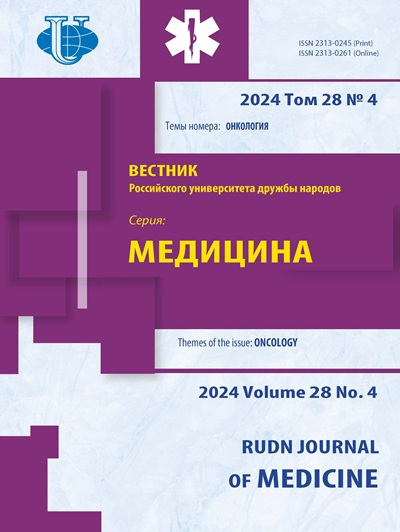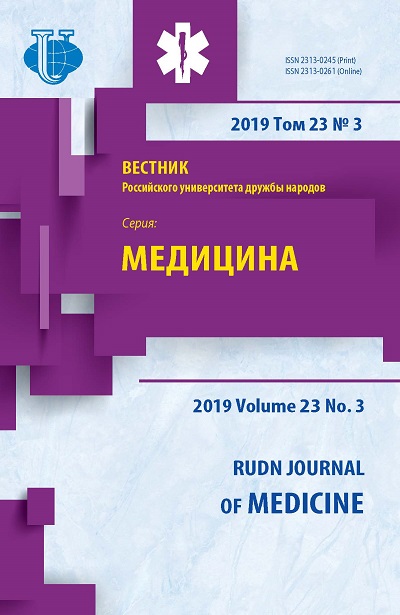Поиск оптимальной модели предикторов окклюзии бедренно-подколенных и бедреннно-тибиальных шунтов
- Авторы: Касьянов Б.В.1
-
Учреждения:
- Орловский государственный университет имени И.С. Тургенева
- Выпуск: Том 23, № 3 (2019)
- Страницы: 271-282
- Раздел: ХИРУРГИЯ. ТРАВМАТОЛОГИЯ
- URL: https://journals.rudn.ru/medicine/article/view/22515
- DOI: https://doi.org/10.22363/2313-0245-2019-23-3-271-282
Цитировать
Полный текст
Аннотация
Актуальность. Факторы риска, влияющие на проходимость шунтов после инфраингвинальных реконструкций, уже известны давно. Но до сих пор не предложена эффективная модель, позволяющая предсказать, в какие сроки и с какой комбинацией факторов риска произойдет окклюзия шунта у того или иного пациента. Цель. Статистический анализ факторов риска окклюзии таких шунтов и разработка достоверной прогностической модели на основе регрессионной функции. Материалы и методы. Был выполнен ретроспективный анализ 136 случаев бедренно-подколенного (БПШ) и бедренно-тибиального шунтирования (БТШ) на базе отделения сосудистой хирургии БУЗ Орловская областная клиническая больница в период с 2008 по 2018 гг. Статистический анализ данных проводился методами ранговой корреляции Спирмана, бинарной логистической регрессии, построением ROC-кривой и графиков выживаемости Каплана-Майера с помощью IBM SPSS Statistics 22. Результаты. Выявлена корреляция почти между всеми анализируемыми факторами и первичной проходимостью. С помощью метода бинарной логистической регрессии составлена достоверная модель прогнозирования вероятности первичной проходимости таких шунтов по значениям признаков: степени ишемии, проходимости поверхностной бедренной артерии, наличие сахарного диабета в анамнезе, дооперационных данных МНО и уровня гемоглобина Hb. Модель обладает высокой прогностической значимостью, специфичностью, чувствительностью и информативностью. Графики выживаемости Каплана-Майера показали зависимость первичной проходимости от степени ишемии и трофических расстройств, наличия у пациентов в анамнезе СД, а также от приема в послеоперационном периоде клопидогрела, аторвастатина/розувастатина, пентоксифиллина и актовегина с течением времени. Заключение. Пациентам, у которых встречаются факторы риска окклюзии, предложенные в разработанной модели, следует в первую очередь советовать пролонгированный прием препаратов аторвастатина/розувастатина, клопидогрела, пентоксифиллина, актовегина (более 1 года, в идеале пожизненно), назначать периодический профилактический осмотр у сосудистого хирурга через 1 мес, 3 мес, 6 мес, 1 год и 2 года после операции с выполнением УЗИ артерий нижних конечностей и шунта, а также советовать таким пациентам сдавать общий анализ крови (уровень лейкоцитов и тромбоцитов).
Об авторах
Б. В. Касьянов
Орловский государственный университет имени И.С. Тургенева
Автор, ответственный за переписку.
Email: borys.kasianov@gmail.com
Орел, Россия
Список литературы
- Папоян С.А., Щеголев А.А., Гавриленко А.В. Современные подходы к хирургическому и эндоваскулярному лечению поражений ортоподвздошного сегмента // Анналы хирургии. 2015. № 5. C. 11-17.
- Багдасарян А.Г. Опыт применения препаратов ацетилсалициловой кислоты в ангиохирургической практике // РМЖ. 2014. Т. 22. № 30. С. 2136-2139.
- Кошкин В.М. и др. Консервативная терапия у больных хроническими облитерирующими заболеваниями артерий нижних конечностей. Современные представления // Медицинский совет. 2015. № 8. C. 6-9. https://doi.org/10.21518/2079-701X-2015-8-6-9.
- TASC Steering Committee et al. An update on methods for revascularization and expansion of the TASC lesion classification to include below-the-knee arteries: a supplement to the Inter-Society Consensus for the Management of Peripheral Arterial Disease (TASC II) // Vascular Medicine. 2015. Т. 20. № 5. С. 465-478. https://doi.org/10.1177/1358863X15597877.
- Митичкин А.Е. и др. Сочетанные эндоваскулярные и реконструктивные операции при многоэтажных поражениях артерий нижних конечностей // Анналы хирургии. 2016. Т. 21. № 3. C. 187-192.
- Чернявский М.А. и др. Клинический случай гибридного лечения пациента с многоуровневым атеросклеротическим поражением артерий нижних конечностей // Патология кровообращения и кардиохирургия. 2018. Т. 22. № 4. С. 103-110. http://dx.doi.org/ 10.21688/1681-3472-2018-4-103-110.
- Никоненко А.С., Волошин А.Н., Матерухин А.Н. Эффективность эндоваскулярной реканализации бедренно-подколенного сегмента у больных с критической ишемией нижних конечностей // Вісник серцево-судинної хірургії. 2015. № 23. С. 130-134.
- Mun Y.S. et al. Femoropopliteal Bypass with Varicose Greater Saphenous Vein // International Journal of Angiology. 2016. Т. 25. № 5. С. e108-e110. https://doi.org/10.1055/s-0035-1546438.
- Schulman M.L., Badhey M.R. Regarding. Autologous alternative veins may not provide better outcomes than prosthetic conduits for below-knee bypass when great saphenous vein is unavailable // Journal of vascular surgery. 2016. Т. 63. №. 4. С. 1131. https://doi.org/10.1016/ j.jvs.2015.11.048.
- De Santis F. et al. Factors Affecting Long-Term Results of Above-Knee Femoropopliteal Bypass: A Single-Center Contemporary Study // Vascular and endovascular surgery. 2016. Т. 50. №. 2. С. 72-79. https://doi.org/10.1177/ 1538574415627866.
- Klinkert P. et al. Saphenous vein versus PTFE for above-knee femoropopliteal bypass. A review of the literature // European journal of vascular and endovascular surgery. 2004. Т. 27. № 4. С. 357-362. https://doi.org/10.1016/ j.ejvs.2003.12.027.
- Sayers R.D. et al. Long-term results of femorotibial bypass with vein or polytetrafluoroethylene // British journal of surgery. 1998. Т. 85. № 7. С. 934-938. https://doi.org/10.1046/j.1365-2168.1998.00765.
- Altreuther M., Mattsson E. Long-Term Limb Salvage and Amputation-Free Survival After Femoropopliteal Bypass and Femoropopliteal PTA for Critical Ischemia in a Clinical Cohort // Vascular and endovascular surgery. 2019. Т. 53. № 2. С. 112-117. https://doi.org/10.1177/1538574418813741.
- Rutherford R.B. et al. Recommended standards for reports dealing with lower extremity ischemia: revised version // Journal of vascular surgery. 1997. Т. 26. № 3. С. 517-538. https://doi.org/10.1016/S0741-5214(97)70045-4.
- Klingelhoefer E. et al. Predictive factors for better bypass patency and limb salvage after prosthetic above-knee bypass reconstruction // Journal of vascular surgery. 2016. Т. 64. № 2. С. 380-388. https://doi.org/10.1016/ j.jvs.2016.02.059.
- Матюшкин А.В., Лобачев А.А. Отдаленные результаты различных методов хирургической реваскуляризации у больных с окклюзией бедренно-подколенного сегмента // Вестник Национального медико-хирургического Центра им. Н.И. Пирогова. 2018. Т. 13. № 2. С. 18-25.
- Суковатых Б.С. и др. Бедренно-подколенное шунтирование свободным аутовенозным трансплантатом ниже щели коленного сустава в лечении критической ишемии нижних конечностей // Новости хирургии. 2015. Т. 23. № 6. C. 637-643.
- Moxey P.W. et al. The BASIL survival prediction model in patients with peripheral arterial disease undergoing revascularization in a university hospital setting and comparison with the FINNVASC and modified PREVENT scores // Journal of vascular surgery. 2013. Т. 57. № 1. С. 1-7.
- Adam D.J. et al. Bypass versus Angioplasty in Severe Ischaemia of the Leg (BASIL): multicentre, randomised controlled trial. Lancet 2005;366:1925-34.
- Bradbury A.W. et al. Bypass versus Angioplasty in Severe Ischaemia of the Leg (BASIL) trial: a survival prediction model to facilitate clinical decision making. J Vasc Surg 2010;51(5 Suppl):52-68.
















